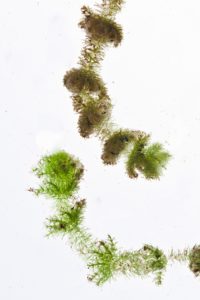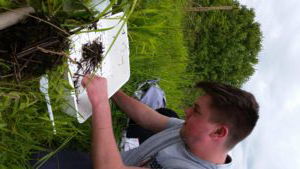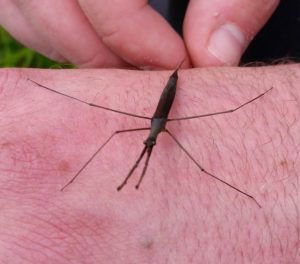Flagship Focus: Orton Pits 2016
23rd June 2016
Welcome to Orton Pits, one the many wonderful pond sites supported by our Flagship Pond project. Thanks to a grant from the Heritage Lottery Fund, we are able to help the people caring for these sites, making sure their special plants and animals have a secure future. Pete Case, People, Ponds & Water Project Officer for Central England, tells us more…
Orton Pits, part of the wider Hampton Reserve, is a legacy of Peterborough’s rich industrial heritage; a former clay extraction site for the once thriving brick manufacturing industry in the City. Excavations and the subsequent deposition of spoil have left a unique undulating landscape with in excess of three hundred ponds formed in linear rows. Cessation of clay extraction in the 1990s means the site is now managed as a nature reserve by the conservation charity Froglife in partnership with landowners O&H Hampton and Natural England.
 Aerial view of Orton Pits (c) Peterborough City Council 2010
Aerial view of Orton Pits (c) Peterborough City Council 2010  A typical Orton Pits pond
A typical Orton Pits pond
Orton is an exceptionally diverse site recognised both as a Special Area of Conservation (SAC) and Site of Special Scientific Interest (SSSI), primarily for its internationally significant population of Great Crested Newts. An estimated 30,000 adult newts make use of the 145 hectare site. Less well known, but equally important, are the ten stonewort species that colonise the bare substrate of many of these ponds, making Orton one of the richest stonewort sites in the UK. Stoneworts, also known as charophytes, may look superficially like plants but are in fact complex algae. Orton Pits is a national stronghold for charophytes including the critically endangered Bearded Stonewort Chara cansecens which was once thought extinct in England, and currently only found at Orton. Also occurring at Orton, and of note, are the nationally scarce (and wonderfully named) Hedgehog, Rough and Bristly Stoneworts.
Freshwater Habitats Trust has been involved in the site for a long time. Back in 1998, when we were Pond Action, we undertook a survey of a small proportion of the ponds. The findings then showed that Orton Pits had a large number of Priority Ponds, supporting outstanding water beetle assemblages, and one of the highest quality pond sites in East Anglia. Work since then by a local expert entomologist has confirmed the importance of the site for rare aquatic and pond edge beetles.
 A recently managed pond, rich in Stoneworts (c) Liz Morrison, Froglife
A recently managed pond, rich in Stoneworts (c) Liz Morrison, Froglife
As early colonisers of ponds, stoneworts don’t tolerate competition well, and to maintain the favoured conditions in the ponds Froglife and Natural England have established a rotational restoration programme – scraping back the bed of some ponds using a combination of mechanical and volunteer effort. Whilst this work has been monitored and its merit assessed, there hasn’t been a full comprehensive survey of the site in recent years taking into account recent restoration work. There is also a question mark over the best management strategy to accommodate the needs of the stoneworts, Great Crested Newts, and beetle communities.
 Bearded Stonewort (c) Sarah Lambert
Bearded Stonewort (c) Sarah Lambert
Thanks to the support from Heritage Lottery Fund through the People, Ponds & Water project, we are able to offer help to Froglife and assist in protecting Orton Pits for the long term in a range of ways. Firstly, we are helping to fund a resurvey of the site which will also include mapping all wetland plants and invertebrates using the PSYM (Predictive System for Multimetrics) method which will score ponds overall quality – a recognised survey methodology that can be repeated in subsequent years. Between Froglife and Freshwater Habitats Trust staff, and supported by our wonderful volunteers, we are surveying 75 ponds. This stratified sample will reflect the different pond types and stages of succession throughout the site. Training for the survey team of volunteers and staff is underway. Later this summer, before the plant surveys begin, we’ll be enlisting the help of stonewort expert and national referee, Nick Stewart, to run a workshop which we hope will be attended by professionals and novices alike.
 Volunteer Aidan McCarthy helping with invertebrate surveys in May 2016
Volunteer Aidan McCarthy helping with invertebrate surveys in May 2016
Understanding and mapping the range of successional stages of the ponds on the site is vital to the long term planning of site management, and the results of the PSYM surveys will help to inform and direct future restoration work, helping the site managers balance the needs of amphibians, stoneworts and invertebrates. Identifying which ponds are significant for invertebrates will ensure these ponds are carefully assessed before any mechanical management takes place. So far, Naomi Ewald the National Coordinator for People, Ponds and Water has surveyed 20 ponds for invertebrates. The results of PSYM analysis has shown that all these ponds qualify as a Priority Ponds. Naomi says “I’m beginning to wade through the samples to identify the beetles to species level. I’d estimate that there are around 25-30 different beetles per sample, so it’s going to be a busy autumn!”.
 The impressive Water Stick Insect (Ranatra linearis) at Orton Pits
The impressive Water Stick Insect (Ranatra linearis) at Orton Pits
Water quality is critical for a site like Orton. Without clean water the sensitive species such as Bearded Stonewort can’t persist. Volunteers have been busy this year using Clean Water for Wildlife test kits, mapping nitrate and phosphate levels across many of the ponds to identify potential sources of pollution. Although the site is enclosed by main roads, a vast housing estate and farmland, water quality has so far proved to be excellent across almost all samples. Now volunteers are trained we can focus attention on the most vulnerable ponds, repeating these water chemistry tests regularly to flag up problems early on and prevent damage to the site. The Flagship Pond project will help to purchase essential equipment for Froglife: a high quality microscope will help staff and volunteers identify stonewort and invertebrate species and will be a legacy of the People, Ponds & Water project into the future.
Want to know more?
- Read more about the Flagship Ponds project
- Learn about other parts of our People, Ponds & Water project, and how you can get involved
- Find out how your support can make a difference for freshwater wildlife
- Join the mailing list to get articles like this, and more, direct to your inbox
